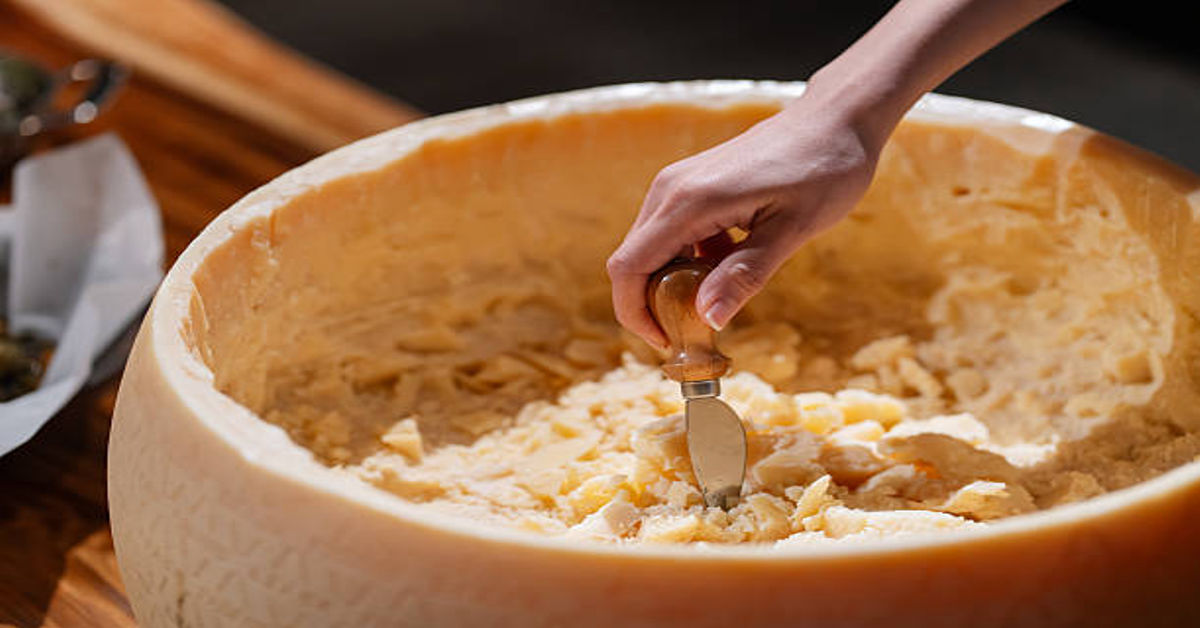Grana Padano is one of Italy’s most beloved and iconic cheeses, admired not only within its homeland but across the world. Known for its hard texture, crystalline grains, and rich nutty flavor, this cheese represents centuries of Italian craftsmanship and culinary artistry. Often compared to Parmigiano Reggiano, Grana Padano has its own distinguished identity, shaped by its geographical origins, production techniques, and the values of sustainability and quality. Understanding Grana Padano is more than learning about cheese—it’s an insight into Italian heritage, agricultural devotion, and the timeless beauty of traditional food-making.
1. The Historical Roots of Grana Padano
The origins of Grana Padano date back nearly a thousand years, to the 11th century. It was first produced by Cistercian monks in the Po River Valley of Northern Italy. These monks lived in the fertile regions of Lombardy and sought ways to preserve excess milk from their dairy farms. Through experimentation, they developed a method of cooking, curdling, and aging milk that resulted in a firm, grainy cheese capable of lasting for years without spoiling.
The name itself tells a story of its character and place of origin. The word “Grana” refers to its grainy texture, while “Padano” signifies the Po River Valley (Pianura Padana), a rich agricultural region stretching from Piedmont to Veneto. Thus, “Grana Padano” literally translates to “Grainy cheese from the Po Valley.”
As centuries passed, Grana Padano became a staple of northern Italian cuisine. Its long shelf life made it valuable during times of scarcity, and its intense flavor elevated even simple peasant dishes. By the Renaissance era, the cheese had already become a prized delicacy enjoyed in noble courts. Today, Grana Padano remains a symbol of regional pride, protected and celebrated under strict European quality standards.
2. Protected Designation of Origin (PDO) and Its Importance
In 1954, Italy officially recognized Grana Padano as a product of unique origin, and in 1996, it received Protected Designation of Origin (PDO) status from the European Union. This means only cheese produced in certain approved regions using specific methods can legally be called Grana Padano. The PDO mark guarantees authenticity, geographical connection, and adherence to traditional production processes.
The Grana-Padano Production Consortium (Consorzio Tutela Grana Padano) is responsible for regulating and protecting the cheese. It ensures that every wheel meets exacting standards related to milk quality, animal welfare, hygiene, and aging. The cheese must be produced in one of the following regions:
- Lombardy
- Piedmont
- Veneto
- Emilia-Romagna (some parts)
- Trentino
Each of these territories contributes unique environmental factors—such as soil, grass, and climate—that influence the final flavor and texture of the cheese.
3. The Traditional Production Process of Grana Padano
Producing Grana-Padano is a careful, multi-stage process rooted in centuries of expertise. The journey from fresh milk to a beautifully aged wheel of cheese takes time, patience, and skill.
Step 1: Milk Collection
Only raw, unpasteurized cow’s milk from approved farms is used. The milk is partially skimmed through natural separation, reducing fat content and ensuring a firm texture.
Step 2: Curdling
The milk is heated in large copper vats and mixed with calf rennet, which causes coagulation. The curd forms and is then cut into tiny granules using a special tool called a spino.
Step 3: Cooking and Resting
The curds are cooked at approximately 53–56°C (127–133°F) to expel whey and develop the signature granular texture. After cooking, the curd settles to the bottom and is collected into linen cloths.
Step 4: Molding and Pressing
Each portion is placed into a round mold known as a fascera, which shapes the cheese into its traditional wheel form. The wheel is imprinted with dotted inscriptions including the “Grana-Padano” name and dairy identification code.
Step 5: Salting
The formed wheels are immersed in brine baths (saltwater) for about 20 days. This enhances flavor, aids preservation, and strengthens the rind.
Step 6: Aging (Maturation)
The cheese is aged in temperature-controlled rooms for a minimum of 9 months, though many are matured for 16, 20, or even 24 months. During this time, the wheel is brushed and turned regularly to ensure uniform texture and flavor.
Each wheel is then inspected by the Consortium’s experts. Only those meeting the highest quality standards receive the official Grana-Padano fire-brand seal, symbolizing authenticity and excellence.
4. Characteristics and Flavor Profile
Grana Padano is instantly recognizable by its pale yellow color, hard and grainy texture, and complex aroma. The taste evolves as it ages—from delicate and milky in young wheels to rich, nutty, and slightly spicy in mature varieties.
| Age (Months) | Texture | Flavor Notes | Use Recommendation |
|---|---|---|---|
| 9–12 | Semi-hard, moist | Mild, milky, slightly sweet | Table cheese, salads, light dishes |
| 16–20 | Firm, crumbly | Nutty, savory, balanced | Grating, risottos, pasta dishes |
| 24+ | Hard, crystalline | Sharp, complex, aromatic | Finishing cheese, gourmet recipes |
The crystals that form in aged Grana-Padano are tyrosine—a natural amino acid that develops as proteins break down during aging. These crystals give a pleasant crunch and a deeper umami taste.
5. Nutritional Composition and Health Benefits
Grana-Padano is not only delicious but also nutritionally dense, making it a valuable addition to a balanced diet. Despite its rich flavor, it provides a concentrated source of protein, calcium, vitamins, and minerals.
Nutritional Table (Per 100g of Grana Padano)
| Nutrient | Amount |
|---|---|
| Energy | 398 kcal |
| Protein | 33 g |
| Fat | 29 g |
| Saturated Fat | 18 g |
| Carbohydrates | 0 g |
| Calcium | 1,150 mg |
| Sodium | 650 mg |
| Cholesterol | 95 mg |
| Vitamin A | 360 µg |
| Vitamin B12 | 1.7 µg |
| Magnesium | 40 mg |
Key Health Benefits
- High-Quality Protein:
Grana-Padano contains all essential amino acids, supporting muscle maintenance, repair, and general vitality. - Rich in Calcium and Phosphorus:
Its high calcium content helps maintain strong bones and teeth, making it suitable for children, athletes, and the elderly. - Lactose-Free:
Due to long aging, Grana-Padano naturally becomes lactose-free, making it digestible for those with lactose intolerance. - Good Source of Vitamins:
It contains vitamin A for vision and skin health, and vitamin B12, which supports nerve function and red blood cell formation. - Energy-Dense but Nutritious:
While calorie-rich, small amounts provide excellent nutrition, flavor, and satiety—encouraging mindful eating.
6. Culinary Uses of Grana Padano
Grana Padano’s versatility in the kitchen is one of its greatest strengths. It can be used as a main ingredient, a garnish, or even as a flavor enhancer. Its distinct taste elevates both simple and sophisticated recipes.
Common Culinary Applications
- Grated over Pasta or Risotto: Aged Grana Padano melts beautifully, adding depth to Italian classics.
- In Soups and Broths: Finely grated cheese enhances the umami and body of minestrone or vegetable soups.
- Shaved in Salads: Young Grana Padano pairs well with arugula, pear, and walnut salads.
- Used in Baking and Savory Pies: Its balanced flavor enriches quiches, frittatas, and gratins.
- Served on Cheese Boards: Complement it with honey, fig jam, grapes, or aged balsamic vinegar for a perfect appetizer.
Its ability to adapt to many cuisines beyond Italian makes it a favorite ingredient for chefs worldwide.
7. Grana Padano vs Parmigiano Reggiano: What’s the Difference?
Although Grana Padano and Parmigiano Reggiano look and taste similar, several distinctions make each unique.
| Aspect | Grana Padano | Parmigiano Reggiano |
|---|---|---|
| Origin | Po Valley (broader region) | Specific provinces like Parma, Modena, Reggio Emilia |
| Aging Time | Minimum 9 months | Minimum 12 months |
| Milk Treatment | Semi-skimmed, from multiple farms | Whole milk, more controlled sourcing |
| Flavor | Milder, slightly sweeter | Stronger, saltier, more granular |
| Texture | Softer and less dry | Harder and more brittle |
| Price Range | Generally lower | Typically more expensive |
In summary, Grana Padano offers a gentler, more balanced flavor, while Parmigiano Reggiano is sharper and more intense. The choice between them often depends on personal taste and recipe requirements.
8. Aging Categories and Flavor Development
The Consortium classifies Grana Padano into three main categories based on maturation:
- Grana Padano (9–16 months): Light and delicate, ideal for fresh salads and sandwiches.
- Grana Padano oltre 16 mesi (over 16 months): More developed flavor suitable for grating or melting.
- Grana Padano Riserva (over 20 months): The pinnacle of maturity, marked by a rich aroma and crystalline texture.
The longer the cheese matures, the lower its moisture content and the deeper its umami intensity.
9. Storage and Preservation Tips
Proper storage maintains Grana Padano’s integrity and flavor.
- Refrigeration: Keep cheese at 4–8°C, wrapped in parchment or cheese paper. Avoid airtight plastic wrap, which can trap moisture.
- Freezing: Not recommended for long-term storage, as it can alter texture. If necessary, freeze grated portions only.
- Handling: Bring to room temperature before serving to maximize aroma and taste.
- Shelf Life: Once opened, consume within 2–3 weeks for the best flavor.
10. The Economic and Cultural Significance of Grana Padano
Beyond its culinary prestige, Grana Padano plays a vital economic and cultural role. With over 5 million wheels produced annually, it is one of the world’s best-selling PDO cheeses. Thousands of dairy farmers, cheesemakers, and inspectors depend on this industry, ensuring the survival of traditional rural economies.
Culturally, it represents the values of authenticity, patience, and respect for nature. Every wheel tells a story of the land, the animals, and the generations who have refined this craft. The cheese embodies Italy’s philosophy that true quality comes from time, care, and passion.
11. Sustainability and Ethical Production
The Grana Padano Consortium enforces strict sustainability measures. Farms must follow environmentally responsible practices, emphasizing animal welfare, low waste, and efficient energy use. Many dairies recycle whey for livestock feed or energy production, minimizing waste and carbon footprint.
Moreover, Grana Padano’s long shelf life and minimal processing make it a low-waste food choice—aligning with the modern push toward sustainable eating.
12. Pairing Grana Padano with Food and Wine
Pairing enhances Grana Padano’s sensory experience. Depending on its age, the cheese matches well with different wines, fruits, and condiments.
| Cheese Age | Ideal Wine Pairing | Complementary Foods |
|---|---|---|
| 9–12 months | Young Chardonnay, Pinot Grigio | Pears, green apples, prosciutto |
| 16–20 months | Barbera, Chianti | Risotto, cured meats, olives |
| 24+ months | Amarone, aged Barolo | Honey, figs, walnuts, balsamic vinegar |
These pairings highlight Grana Padano’s versatility, bridging everyday dining and fine gastronomy.
13. Global Influence and Modern Popularity
Today, Grana Padano enjoys international acclaim. It’s exported to over 130 countries, appreciated by chefs and home cooks alike. Whether grated over pasta in Milan, added to soups in London, or enjoyed with wine in New York, it symbolizes Italian excellence.
Television chefs and culinary influencers have further elevated its status, promoting its use in creative, modern recipes—like Grana Padano-infused butter, risotto fillings, or even ice cream toppings.
14. How to Identify Authentic Grana Padano
When buying Grana Padano, authenticity is key. Always look for:
- The “Grana Padano PDO” fire-branded mark on the rind.
- The dotted “Grana Padano” inscription around the wheel.
- The Consortium seal indicating inspection and certification.
- Vacuum-sealed packages with traceable lot numbers.
These symbols guarantee genuine origin and quality.
15. Final Thoughts
Grana Padano is more than a cheese—it’s a masterpiece of human tradition and natural artistry. Every bite reflects centuries of care, a harmonious relationship between farmers, animals, and the land. From its humble beginnings in monastic kitchens to its place on global dining tables, Grana Padano remains a celebration of simplicity, craftsmanship, and enduring Italian excellence.
Whether enjoyed freshly grated over pasta, savored in thin slices with wine, or incorporated into modern dishes, Grana Padano continues to unite past and present through flavor, nutrition, and authenticity.
Frequently Asked Questions (FAQs)
1. What makes Grana Padano different from Parmesan cheese?
Grana Padano has a slightly milder, sweeter flavor and is produced in a wider area. Parmesan (Parmigiano Reggiano) is more intense and aged longer. Both are PDO cheeses but have distinct regional rules and characteristics.
2. Is Grana Padano suitable for lactose-intolerant people?
Yes. During its long aging process, lactose naturally breaks down, making Grana Padano virtually lactose-free and easily digestible.
3. How should Grana Padano be stored after opening?
Wrap it in waxed or parchment paper and store it in the refrigerator at 4–8°C. Avoid plastic wrap and ensure airflow to prevent moisture buildup.
4. Can Grana Padano be used for cooking as well as eating raw?
Absolutely. Grana Padano melts well and enriches pastas, risottos, soups, and sauces, while also tasting wonderful in raw slices or shavings.
5. What are the main nutritional benefits of Grana Padano?
It’s a protein-rich, calcium-dense cheese that supports bone health, muscle strength, and provides essential vitamins such as A and B12.









